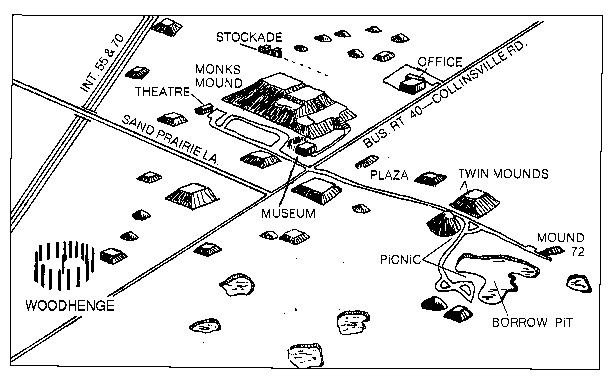Woodhenge
Jack Kramer
If you tool down Route 55, within sight of St. Louis near the Illinois town of Collinsville you'll see a sign that points to Cahokia Mounds. If you look to the south, you may see some of these mounds. The area was first inhabited around 700 A.D. by Indians of the Late Woodland culture. Somewhere in the period 850 to 900 A.D., they were superceded by people of the Mississippian culture who built a city that covered nearly six square miles and was home to tens of thousands of people. The mounds are completely made of earth and around them archaeologists have discovered foundations that tell something about the buildings that were a part of this city. Monk's Mound is the largest of the earthenworks; it covers fourteen acres and rises to a height of 100 ft. Atop the highest terrace, evidence has been found of a building that was 105 ft. long, 48 ft. wide, and probably about 50 ft. high. It is surmised that this was the seat of the government. The purpose of the mounds was primarily as ceremonial sites for the populace; however, burials were found on some of the mounds, which suggests that a few have been the last resting places of prominent rulers. One of the mounds contained nearly 300 sacrificial burials. There's a new museum on site with interesting displays of many artifacts.

As for the archaeoastronomy, excavations have uncovered what is believed to be the remains of four circular Sun calendars made of large, evenly-spaced log posts. Because of their functional similarity to the famous Stonehenge in England, these calendars have been dubbed "Woodhenge". Standing at the center of a circle, the Indians would see the sunrise aligning with the circumference posts, thus marking the different times of the year and important ceremonial periods for this agricultural community. Dating of the circles places their construction around 1000 A.D. One of the Sun circles has been reconstructed in the original location. It consists of 48 large cedar posts, 410 ft. in diameter, with a large central post. Special sunrise programs are scheduled throughout the year. I'm curious about one thing, however: why would posts be on the north-facing sides of the circles - a direction in which the Sun does not rise?
 Published in the March 1993 issue of the NightTimes
Published in the March 1993 issue of the NightTimes





